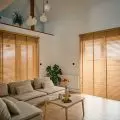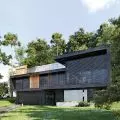Can urban space and architecture have features that make them welcoming to people who identify as queer? The landscape of Polish spaces where LGBTQ+ people can feel comfortable is outlined by Lucjan Rostkowski-Covington.
In „Safely Visible: An Investigation Into Polish Queer Space,” research project, Lucjan first asked Polish LGBTQ+ people how they define a safe queer space. Next, the author conducted a full case study of 6 participatory queer community incubator spaces in Warsaw, Poland followed by a mini study of queer spaces in Poznan, Poland and one important outdoor event, the Warsaw Equality Parade. This let Rostkowski-Covington, who is a M.Arch Candidate at the University of Michigan, to compare case studies by using variables that include exterior safety, interior safety, location, programs, public vs. private space, people, decor, circulation, and violence experienced.
worst in the EU
Given that the International Lesbian, Gay, Bisexual, Trans and Intersex Association (ILGA Europe) ranked Poland last in the European Union for LGBTQ+ rights and protections in 2020, 2021, and 2022, the existence of queer spaces in Poland are more important than ever before. The reality, however, is that queer spaces are transient for a multitude of reasons so it”s imperative to document them while they still exist.
space of respect
Equality Parade 2022, Base by Inclusive.buzz
photo by Lucjan Rostkowski-Covington
The findings of the survey show that Poles feel as though a safe queer space is one where their gender identity is respected, they can feel free to be themselves, they know that LGBTQ+ people frequent these spaces, there are events geared toward LGBTQ+ people, and it”s visibly queer with emblems such as flags and stickers. The case study findings show that prohibiting alcohol consumption, thinking through physical safety measures if necessary, asking for people”s pronouns, employees and customers looking out for each other to make sure the people attending events are acting in a respectful manner, and all employees, including bouncers, having had LGBTQ+ diversity training creates a safe queer space.
queer architecture?
Reverberations
photo by Lucjan Rostkowski-Covington
But how can architecture and urban planning influence the creation and functioning of such spaces? What role should architects take in this process? Lucjan Rostkowski-Covington answered these questions in an interview with architekturaibiznes.pl
Kacper Kępiński: What are the qualities or features of a space that make a place lgbt-friendly?
Lucjan Rostkowski-Covington: Each queer space is unique in its own way—from governance, to aesthetics, to the sociality created in the space. From the survey that I conducted during pride month in 2022, I found that what allows for queer-friendly spaces to thrive is a respect for how people identify, visibility in the form of pride flags, posters and stickers, and being surrounded by like-minded individuals.
Read also: Gentrification forces Pogłos to look for new premises
KK: Do we have queer spaces in Poland? How did you choose the sites for the study?
LRC: I define queer space just as B.D. Wortham-Galvin has as one that acts more broadly as a destabilization of the norm. With this being said, Poland has quite a lot of queer spaces—and Warsaw in particular—and this is because there is a need for these types of spaces to exist in a physical form. I narrowed my focus down by looking for spaces in which the owners, employees, and community members genuinely care about creating a diverse, participatory environment for all to frequent. It's more about creating a sense of community than just running a business to turn a profit.
operating model
Younger Sister
Photo by Lucjan Rostkowski-Covington
KK: What are the key findings of your research? Could you briefly characterize the sites?
LRC: The findings of my research speak to the social and physical adaptations that allow for LGBTQ+ people to feel safe in a queer space in Poland. This includes employees in the spaces having had diversity training at Pogłos, prohibiting alcohol consumption at Inclusive.buzz, respecting people's pronouns at Margines Barber, an intentional decision not to hire security at Młodsza Siostra, and people looking out for each other at Ada Puławska. I want to stress that this is in no way a complete list of adaptations—but rather a sampling and a suggestion of what might allow individuals to feel safe.
I see a strong throughline of spaces engaging with horizontal governance and funding structures, such as with a social cooperative pooling of resources—especially at Ada Puławska. I want to emphasize this method as one that can be applicable to design in a post-capitalist society.
queer architects
KK: How can architects create more inclusive spaces for queer people? What tools do they have?
LRC: At a very basic level, architects have the tools necessary to design spaces. To challenge the traditional notion of the client-architect relationship as simply a commodity—we must go beyond the scope of practice. As mentioned by Tatjana Schneider and Jeremy Till, I too wish to see the architect as the anti-hero—someone who co-authors a project from the beginning and relinquishes power and authority to community members. As architects—we must also work in an interdisciplinary manner—engaging and acting as mediators with urban planners, policy makers, researchers, etc., these partnerships will strengthen our design projects and move them beyond conceptual ideas and into reality. As designers, we cannot work in a vacuum.
Also read: The Architecture of Discrimination — an interview with Dominika Janicka.
The underlying question here is whether or not queerness is something that can be designed or if it's up to the people who will occupy the space to layer their own artifacts over time that will embody their own definition of what it means to be queer. In Inclusive.buzz for example, INSPACE Architects, who designed the interiors, seemingly took a more backseat approach to designing queerness and the individuals in the space over time have layered their own artifacts on the walls in the form of murals, art, posters, and flags.
KK: Can queer spaces also exist on an urban scale?
LRC: If we think about the queer spaces in Warsaw as a network of social infrastructure and how they support one another, we can start to understand them at the urban scale. One example of this is with Pogłos and how Ada Puławska and Chmury have been offering more alternative concerts and queer events in the wake of its closure. I think that paths of transportation can be seen as queer space as well—from pride parade routes to modes of public transportation that allow people to travel between various queer spaces in one city or place. The transient nature of queer space allows it to exist in many spaces at once.
respect
photo by Lucjan Rostkowski-Covington
KK: Can students be taught to design queer spaces?
LRC: I think students can be taught methods of participatory design processes that can be applicable to the formation of queer spaces—from stakeholder engagement to ethnographic research methods for evidence-based design to interdisciplinary teamwork.
KK: What are the biggest challenges or threats to lgbt-friendly spaces in Poland?
LRC: The largest threat will continue to be far-right hatred. I have also observed tension between non-institutional queer spaces and city government in Warsaw. I believe that there should be more support from the city of Warsaw for the funding of queer spaces, both institutional and non-institutional.
The full research report Safely Visible. An Investigation Into Polish Queer Space is available at: LINK
Lucjan Rostkowski-Covngton is an architecture student based in Ann Arbor, Michigan of Polish and British descent. They are currently finishing their Master”s degree in architecture from the University of Michigan”s Taubman College. In the first half of 2023, they will be working on their thesis project, which seeks to understand the relationship between the queer body and queer space and how to memorialize once important community spaces that no longer exist. Lucjan”s interests span architecture, urbanism, and ethnographic research.

































































